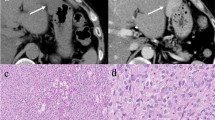Abstract
Background: Trefoil peptides (TFF-1, 2, 3) are a family of protease-resistant regulatory factors that play a role in mucosal restitution, angiogenesis, apoptosis, and tumor progression. Intestinal trefoil peptide (TFF-3) expression has been demonstrated in benign hepatobiliary diseases, but there are limited data regarding its expression in HCC.
Methods: Thirty consecutive cases of HCC from 1998 to 2003 were studied. Immunohistochemistry was performed on formalin-fixed paraffin-embedded blocks of HCC using polyclonal antibody to TFF-3. TFF-3 expression was classified as strong, moderate, weak, focal, and negative. Clinical data were obtained per an IRB-approved protocol.
Results: Median age was 69 yr (range: 39–83 yr). Twenty- three patients were males and 7 were females. Treatments included hepatic resection (n=16), chemo-embolization (n=4), combined modality therapy (n=5) and no treatment (n=4). HCC was well differentiated in 12 (40%), moderately differentiated in 13 (43%), and poorly differentiated in 5 (17%) patients. TFF-3 expression was detected in 28/30 (93.3%) patient samples. Sixteen patients (53%) had moderate and 1 (3%) patient had strong TFF-3 expression. Tumor/normal tissue interface was assessable in 21 cases; 11 cases expressed TFF-3 at the interface. There was a strong correlation between tumor grade and TFF-3 expression, wherein poorly differentiated tumors had moderate/strong TFF-3 expression (p=0.008). There was no correlation between TFF-3 expression and survival (p=0.77). Furthermore, there was no correlation among age, disease stage, and survival.
Conclusion: TFF-3 is commonly expressed in HCC and its expression correlates with tumor grade.
Similar content being viewed by others
References
Parkin DM, Bray F, Ferlay J, et al. Estimating the world cancer burden: GLOBOCAN 2000. Int J Cancer 2001;94:153–156.
Tanaka Y, Hanada K, Mizokami M, et al. A comparison of the molecular clock of the hepatitis C virus in the United States and Japan predicts that hepatocellular carcinoma in the United States will increase over the next two decades. Proc Natl Acad Sci 2002;99:15,584–15,589.
Podolysky DK, Lynch-Devaney K, Stow JL, et al. Identification of human intestinal trefoil factor: goblet cell specific expression of a peptide targeted for apical secretion. J Biol Chem 1993;268:6694–6702.
Dignass A, Lynch-Devaney K, Kindon H, et al. Trefoil peptides promote epithelial migration through a transforming growth factor β -independent pathway. J Clin Investig 1994;94:376–383.
Poulsom R, Begos DE, Modlin IM. Molecular aspects of restitution: functions of trefoil peptides. Yale J Biol Med 1996;69:137–146.
Yamachika T, Werther JL, Bodian C, et al. Intestinal Trefoil Factor: A marker of poor prognosis in gastric carcinoma. Clin Cancer Res 2002;8:1092–1099.
Srivastva G, Giraud AS, Ulaganathan M, et al. Biliary epithelial trefoil peptide expression is increased in biliary diseases. Histopathology 2002;40:261–268.
Sasaki M, Tsuneyama K, Saito T, et al. Site-characteristic expression and induction of trefoil factor family 1,2 and 3 and malignant brain tumor-1 in normal and diseased intrahepatic ducts relates to biliary pathophysiology. Liver International 2004;24:29–37.
Sasaki M, Ikeda H, Ohira S, et al. Expression of trefoil factor family 1,2 and 3 peptide is augmented in hepatolithiasis. Peptides 2004; 25:763–770.
Tan D, Li Q, Ramnath N, et al. Prognostic significance of expression of p53 oncoprotein in primary (stage I-IIIa) non-small cell lung cancer. Anticancer Res 2003;23:1665–1672.
CLIP. Prospective validation of the CLIP score: a new prognostic system for patients with cirrhosis and hepatocellular carcinoma. Hepatology 2000;31:840–845.
Hoffman W, Jagla W, Wiede A. Molecular medicine of TFF peptides: from gut to brain. Histol Histopathol 2001;16:319–334.
Hoffman W, Jagla W. Cell type specific expression of secretory TFF peptides: colocalization with mucins and synthesis in the brain. Int Rev Cytol 2002;213:147–181.
Jagla W, Wiede A, Dietzmann K, et al. Co-localization of TFF3 peptide and oxytocin in the human hypothalamus. FASEB J 2000;14:1126–1130.
Emami S, Rodrigues S, Rodrigie CM, et al. Trefoil factor family (TFF) peptides and cancer progression. Peptides 2004;25:885–898.
Uchino H, Kataoka H, Itoh H, et al. Expression of intestinal trefoil factor mRNA is downregulated during progression of colorectal carcinoma. J Clin Pathol 1997;50:932–934.
May F, Westley B. Expression of human intestinal trefoil factor in malignant cells and its regulation by oestrogen in breast cancer cells. J Pathol 1997;182:404–413.
Okada H, Kimura MT, Tan D, et al. Frequent trefoil factor 3 (TFF3) overexpression and promoter hypomethylation in mouse and human hepatocellular carcinomas. Int J Oncol 2005;26:369–377.
Efstathiou JA, Noda M, Rowan A, et al. Intestinal trefoil factor controls the expression of the adenomatous polyposis coli-catenin and the E-cadherin-catenin complexes in the human colon carcinoma cells. Proc Natl Acad Sci USA 1998;95:3122–3127.
Buschenfelde DM, Hoschutzky H, Tauber R, et al. Molecular mechanisms involved in TFF3 peptide -mediated modulation of the E-cadherin/catenin cell adhesion complex. Peptides 2004;25:873–883.
Liu D, el-Hariry I, Karayiannakis AJ, et al. Phosphorylation of beta-catenin and epidermal growth factor receptor by intestinal trefoil factor. Lab Invest 1997;77:557–563.
Chen YH, Lu Y, De Plaen IG, et al. Transcription factor NF-kappa B signals antianoikic function of trefoil factor 3 on intestinal epithelial cells. Biochem Biophys Res Commun 2000;274:576–582.
Rodrigues S, Van Aken E, Van Bocxlaer S, et al. Trefoil factors as proangiogenic factors in vivo and in vitro: implications of cyclooxygenase-2 and EGF receptor signaling. FASEB J 2003;17:7–16.
Parasole R, Izzo F, Perrone F, et al. Prognostic value of serum biological markers in patients with hepatocellular carcinoma. Clin Cancer Res 2001;7:3504–3509.
Taupin D, Pederson J, Familari M, et al. Augmented intestinal trefoil factor (TFF3) and loss of pS2 expression precedes metaplastic differentiation of gastric epithelium. Lab Invest 2001;81:397–408.
Author information
Authors and Affiliations
Corresponding author
Rights and permissions
About this article
Cite this article
Khoury, T., Chadha, K., Javle, M. et al. Expression of intestinal trefoil factor (TFF-3) in hepatocellular carcinoma. Int J Gastrointest Canc 35, 171–177 (2005). https://doi.org/10.1385/IJGC:35:3:171
Issue Date:
DOI: https://doi.org/10.1385/IJGC:35:3:171




